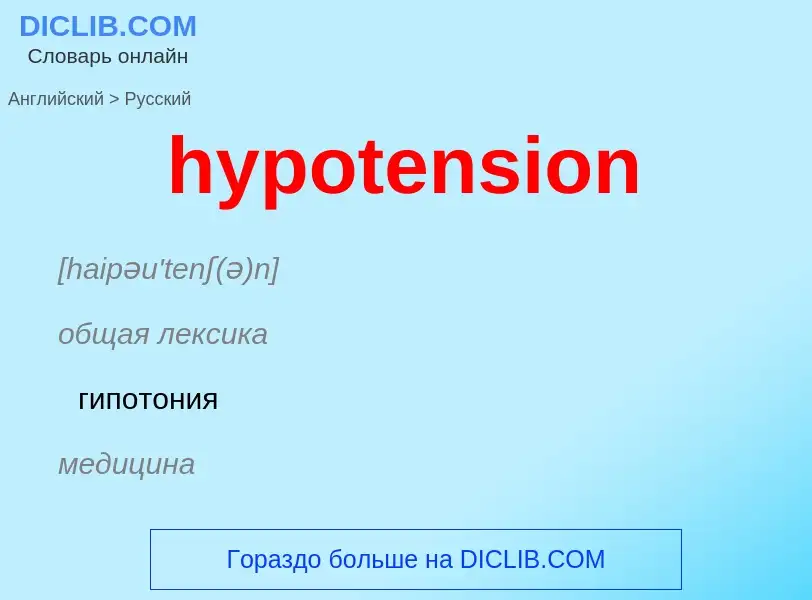Traducción y análisis de palabras por inteligencia artificial ChatGPT
En esta página puede obtener un análisis detallado de una palabra o frase, producido utilizando la mejor tecnología de inteligencia artificial hasta la fecha:
- cómo se usa la palabra
- frecuencia de uso
- se utiliza con más frecuencia en el habla oral o escrita
- opciones de traducción
- ejemplos de uso (varias frases con traducción)
- etimología
hypotension - traducción al ruso
[haipəu'tenʃ(ə)n]
общая лексика
гипотония
медицина
артериальное низкое давление
пониженное давление
существительное
медицина
гипотония
пониженное кровяное давление
медицина
контролируемая гипотензия
управляемая гипотензия
[haipəu'tensiv]
общая лексика
понижающий артериальное давление
больной с пониженными артериальным давлением
гипотоник
медицина
гипотензивный
прилагательное
общая лексика
гипотензивный
снижающий кровяное давление
медицина
характеризующийся гипотензией
страдающий гипотензией
существительное
[haipəu'tensiv]
общая лексика
гипотензивное средство
медицина
гипотоник
Definición
Wikipedia
 patient getting her blood pressure checked.png?width=120)
Hypotension is low blood pressure. Blood pressure is the force of blood pushing against the walls of the arteries as the heart pumps out blood. Blood pressure is indicated by two numbers, the systolic blood pressure (the top number) and the diastolic blood pressure (the bottom number), which are the maximum and minimum blood pressures, respectively. A systolic blood pressure of less than 90 millimeters of mercury (mmHg) or diastolic of less than 60 mmHg is generally considered to be hypotension. Different numbers apply to children. However, in practice, blood pressure is considered too low only if noticeable symptoms are present. Symptoms include dizziness or lightheadedness, confusion, feeling tired, weakness, headache, blurred vision, nausea, neck or back pain, an irregular heartbeat or feeling that the heart is skipping beats or fluttering, or fainting.
Hypotension is the opposite of hypertension, which is high blood pressure. It is best understood as a physiological state rather than a disease. Severely low blood pressure can deprive the brain and other vital organs of oxygen and nutrients, leading to a life-threatening condition called shock. Shock is classified based on the underlying cause, including hypovolemic shock, cardiogenic shock, distributive shock, and obstructive shock.
Hypotension can be caused by strenuous exercise, excessive heat, low blood volume (hypovolemia), hormonal changes, widening of blood vessels, anemia, vitamin B12 deficiency, anaphylaxis, heart problems, or endocrine problems. Some medications can also lead to hypotension. There are also syndromes that can cause hypotension in patients including orthostatic hypotension, vasovagal syncope, and other rarer conditions.
For many people, excessively low blood pressure can cause dizziness and fainting or indicate serious heart, endocrine or neurological disorders.
For some people who exercise and are in top physical condition, low blood pressure could be normal. A single session of exercise can induce hypotension and water-based exercise can induce a hypotensive response.
Treatment depends on what causes low blood pressure. Treatment of hypotension may include the use of intravenous fluids or vasopressors. When using vasopressors, trying to achieve a mean arterial pressure (MAP) of greater than 70 mmHg does not appear to result in better outcomes than trying to achieve a MAP of greater than 65 mmHg in adults.

 patient getting her blood pressure checked.png?width=200)
